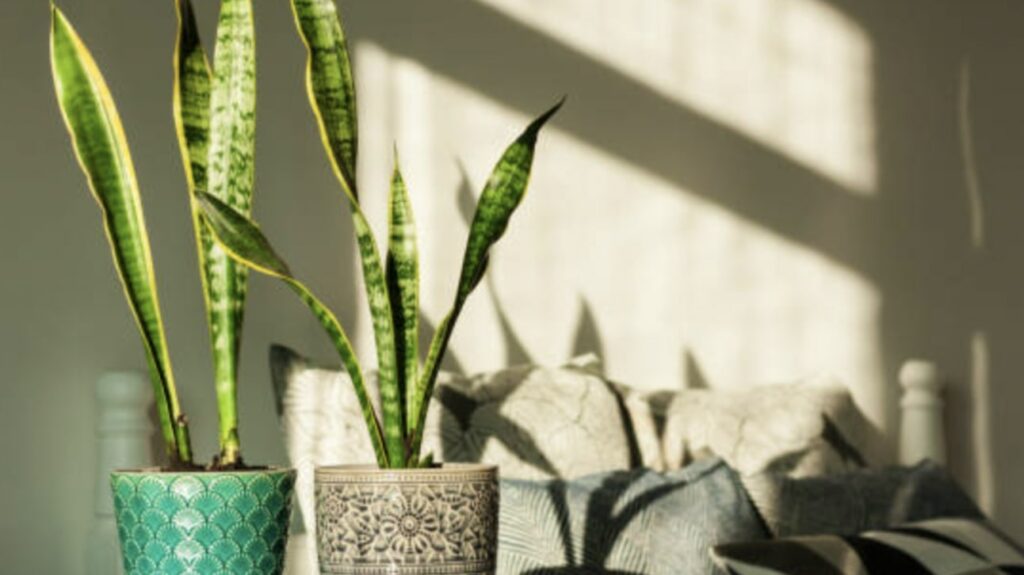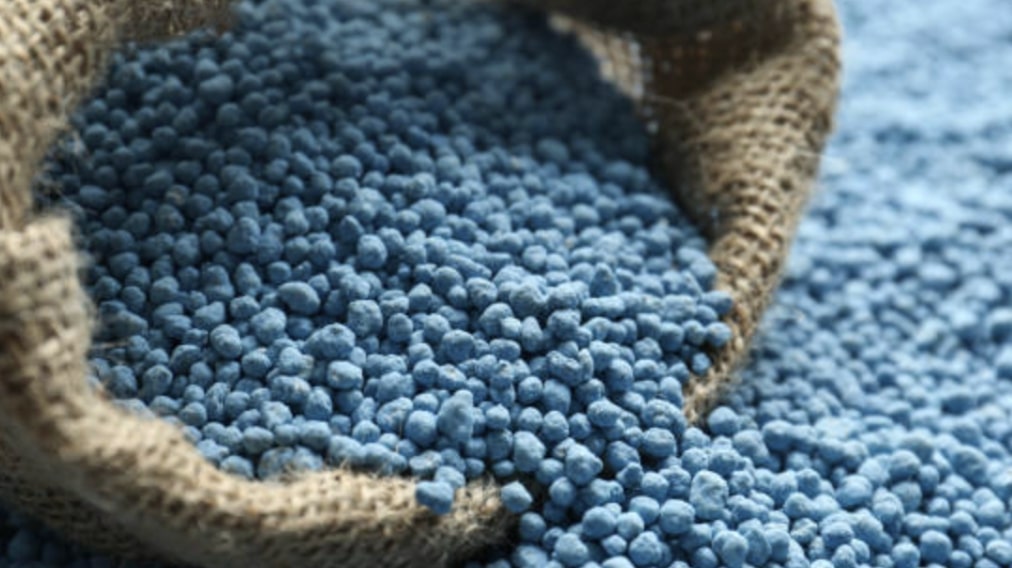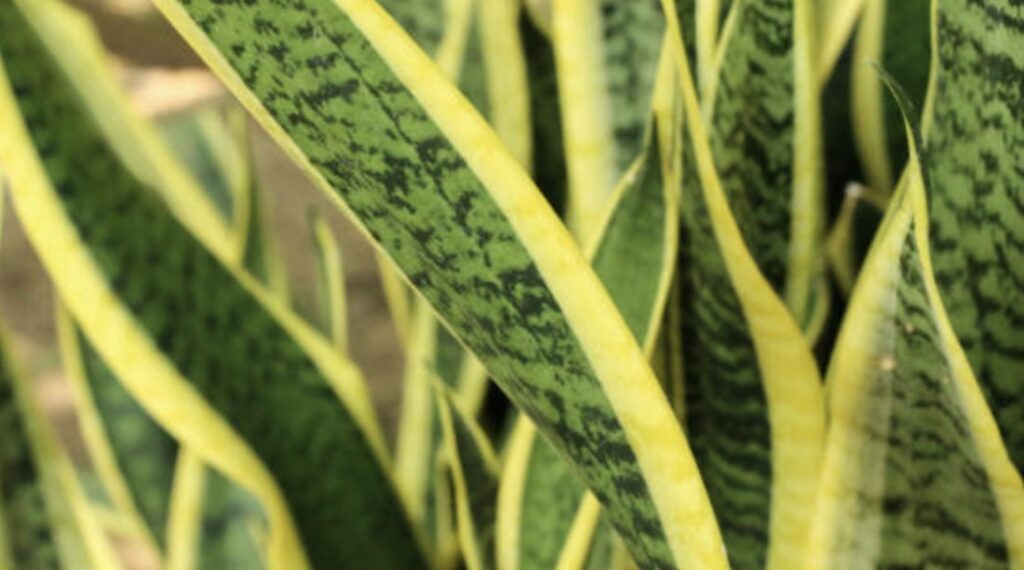A snake plant can have yellow leaves for many reasons, but the most common cause is overwatering. Remember, watering these plants must only be done when the upper half of the soil is dry.
Aside from that, the leaves can yellow through lack of water, overfeeding, age, poor light, cold weather, and pests. In short, snake plants will produce yellow blooms if they aren’t given the proper care.
Scroll down to learn more about these reasons and the things you can do to remedy this problem. This should allow your snake plant to grow awesome and healthy at your house!
1) Overwatering
Many people unintentionally overwater their snake plant. As a result, the plants get yellow leaves and root rot, which will ultimately lead to their demise.
Some say that it’s ideal to water them once a week, and some say it would be better to water them once every fortnight.
But because snake plants’ needs vary in relation to their species, location, and season, it’s a lot safer to water them when the top 50% layer of the soil has become dry.
This rule applies even during the winter season. Generally, watering the snake plant once a month in winter will suffice.
Still, check to see whether the soil is dry before doing so.
2) Lack of Water
Similar to other plants and flowers, a snake plant will develop yellow leaves if it’s not been given ample water.
From a human’s perspective, it may seem like a trivial thing, but for plants, it’s a battle for survival. Not watering them as needed makes them suffocate and shut down.
That’s because they can’t deliver and use the nutrients for creating food through the process of photosynthesis. Water is responsible for transporting these nutrients throughout the plant.
Therefore, to fix this issue, water the plant when the top 3 to 4 inches of the soil becomes dry. Be aware that you would need to water them more often during drought periods.
3) Poor Drainage


Poor drainage means the water hasn’t drained out of the soil completely to allow the snake plant to dry. And so the root becomes damaged and the leaves turn yellow.
Giving your plant excellent drainage relies on two things: the snake plant’s potting mix and the pot vessel.
- Soil Mix
First, the potting mix should ideally allow enough air and water in so it can efficiently move nutrients to the plant tissue, which is necessary for the snake plant’s healthy growth.
Just any kind of soil won’t do for your precious snake plant. Instead, you can use this recipe: 2 parts coarse sand or perlite, 1 part coconut coir or peat moss, and 1 part garden soil or potting mix.
Let’s take a look at some of these soil components:
Sand helps to loosen the soil as well as increase its air passage and drainage, whereas perlite is a type of small volcanic rock that doesn’t absorb much water.
Peat moss is a great ingredient because it holds more nutrients and retains the needed moisture for the plant. Coconut coir functions somewhat similarly to peat moss except that it hardens more in the soil.
The right potting mix should be dry and loose—one that can hold just enough moisture and drain well. Also, it’s great to be mixed with organic matter or fertilizer for optimal plant growth and health.
- Pot Vessel
Your snake plant pot vessel is also important. Make sure you pick one that has drainage holes to let the water out so the soil will dry out at a normal rate.
In addition to this, you can place a round plastic container below the snake plant pot so water won’t spill out into your house or garden. And don’t forget to empty the catch container of water afterwards.
4) Not Applying Fertilizer
Although snake plants are low-maintenance plants, that doesn’t mean you shouldn’t feed them.
For this, add organic matter to the soil mix or fertilizer on the top soil area beneath the drip lines (longest foliage sides) of the plant.
These are food to the plants, giving them nutrients—in particular, nitrogen, potassium, and phosphorus—to survive and grow at their very best.
The best fertilizer to use for snake plants is a well-balanced fertilizer. However, you should always follow the packaging instructions that come with the fertilizer for the best results.
Besides applying the right fertilizer, you have to apply them at the right time, which should be twice a year, in their growing seasons of early spring and early summer.
5) Overfertilizing


The opposite is also a culprit of yellowing snake plant leaves. These plants need nutrients all right, but they can’t be overfed.
What will happen is that the leaves will turn yellow on their tips. However, soon enough, the whole leaf will turn yellow.
Other equally harmful effects are plant burns due to the salt content of the fertilizer, wilting, and fertilizer deposits on certain soil portions.
To prevent overfertilizing your snake plant, you have to focus on two things: correct fertilizer dosage and frequency.
Granular and liquid fertilizers are quite strong and can affect the snake plant negatively. Consequently, they must be diluted first with water if you decide to use them.
Next, the fertilizer must be applied in early spring and summer. That translates to twice every year—no more, no less.
Do note that this rule applies to all sorts of snake plants, including repotted and propagated ones.
6) Incorrect Temperature
Being native to rocky and dry areas in Africa, snake plants grow best in warm temperatures between 70℉ and 90℉.
That’s why they’re also great to grow indoors at room temperature.
So anything below or higher than the range given above will detrimentally affect the plant, including causing unsightly yellow leaves.
And you should definitely not place them outside under drafty and wintry weather, as it can kill the snake plant.
7) Lack of Sunlight


Snake plants prefer bright and indirect light. But it doesn’t follow that they can be permanently in low-light or dark areas because even though they can survive such conditions, these places can harm them over time.
Thus, make it a point to check if they’re getting enough sunlight every day. If not, simply move them to a better spot, perhaps by the window, glass sliding door, or outside in your small garden.
8) Plant Age
Most snake plants reach 5 or 10 years of age. But hardy ones can live up to an astonishing 25 years depending on how the owner has taken care of the plant.
But similar to all plants, a snake plant’s leaves can become brown and yellow as they age. When they’re removed or cut off, new and beautiful ones will sprout from the same branch.
So, there’s nothing you can do about the age of your plant. Nevertheless, you should work to take care of your snake plant in the best way you can.
9) Pests
Look out for pesky insects like spider mites, thrips, aphids, and mealybugs. They can suck the sap or chief fluid of a plant, thereby causing yellow or falling leaves, wounding, and death, eventually.
When you spot these minute creatures, you can give them as well as their eggs and larvae a sharp spray of water and wipe them off the plant with a wet and soapy cloth. Or better yet, kill them using horticultural or insecticidal soap or solution.
But if the pest situation has become dire, it would be better to throw away the plant. Insisting on keeping it may result in your nearby plants being affected as well.
FAQs about Yellowing Snake Plant Leaves


- Is some yellowing leaves on snake plants normal?
Yellowing is normal in these two cases: a) some snake plant varieties have a natural yellow strip giving them a distinct style and character and b) they are old, which results in brown or yellow leaves that will fade and drop.
Other than that, yellowing leaves on the snake plant may be a sign of a problem, such as overwatering, lack of fertilizer, extreme cold, poor drainage, disease, and pest infection.
- Can the snake plant’s leaves turn green again?
The leaves of a snake plant can turn green again if the yellowing is only partial and the cause is a slight mineral deficiency.
But for fuller leaf yellowing and more severe and certain cases like pest infestation, age, or root rot, they may not be able to regain their lost color.
- How to treat a yellow-leaved snake plant?
Fortunately, snake plants with yellowing leaves can still be treated. Not all is lost.
The best thing to do for this is, given you have not cared for it rightly, to repot the plant in the best soil. That is garden soil mixed with coarse sand or perlite, peat moss, and organic matter.
Plus, you have to keep it in a place between 70℉ and 90℉ and water it when the top 50% of the soil is or feels dry.
- Should I cut out yellow leaves on my snake plant?
Examine the plant and see whether there are only a couple of yellow leaves or a lot. In most cases, it’s best to remove or cut it out with sharp garden shears.
In doing so, you will enable the plant to channel its energy into growing a new green leaf from the exact spot of the old leaf.
And more importantly, you should seek to correct the problem that has caused the leaf to yellow in the first place. This way, you can be sure that the plant will look fresh and lovely from this moment on.
More Plant Care Guides
Check out our other plant and flower care guides below:



